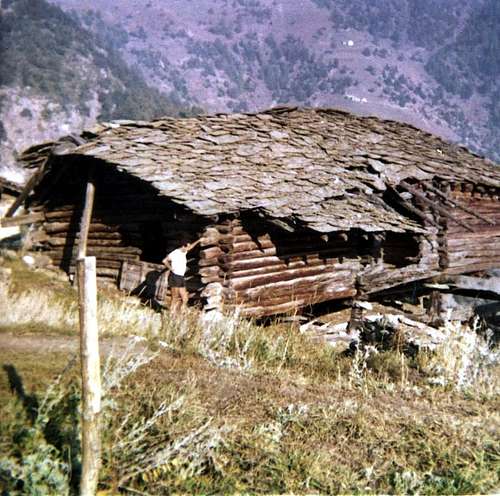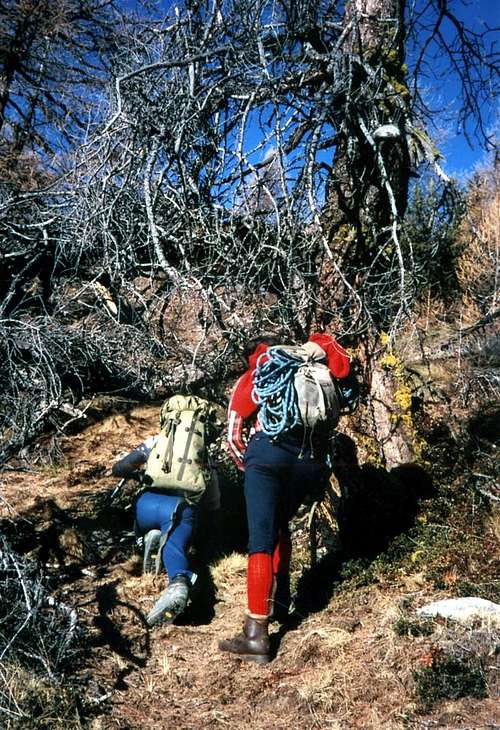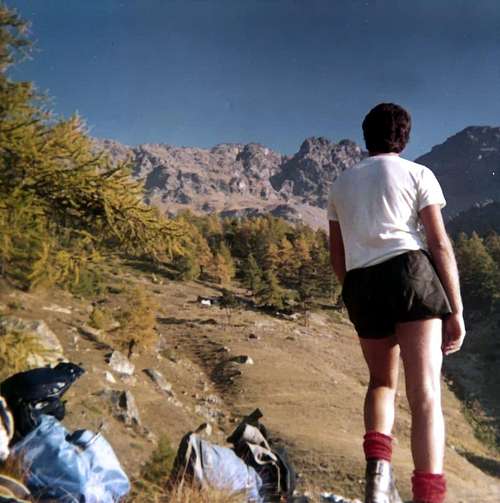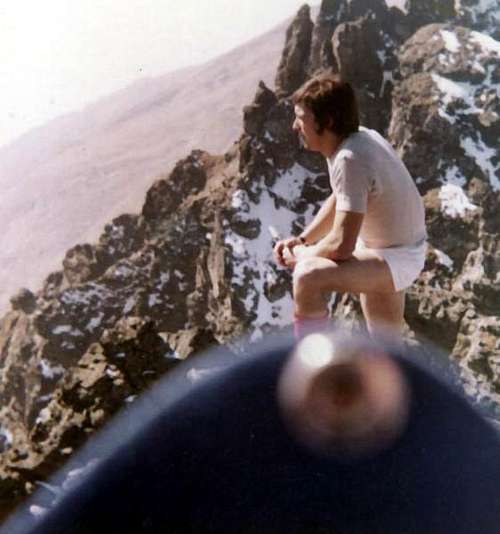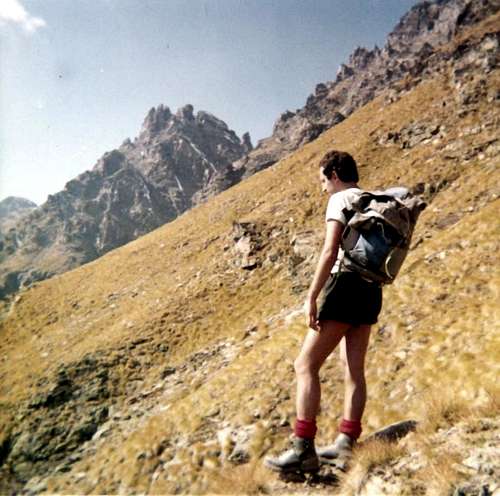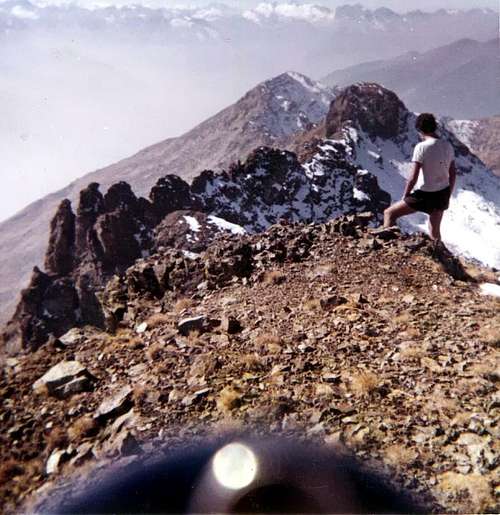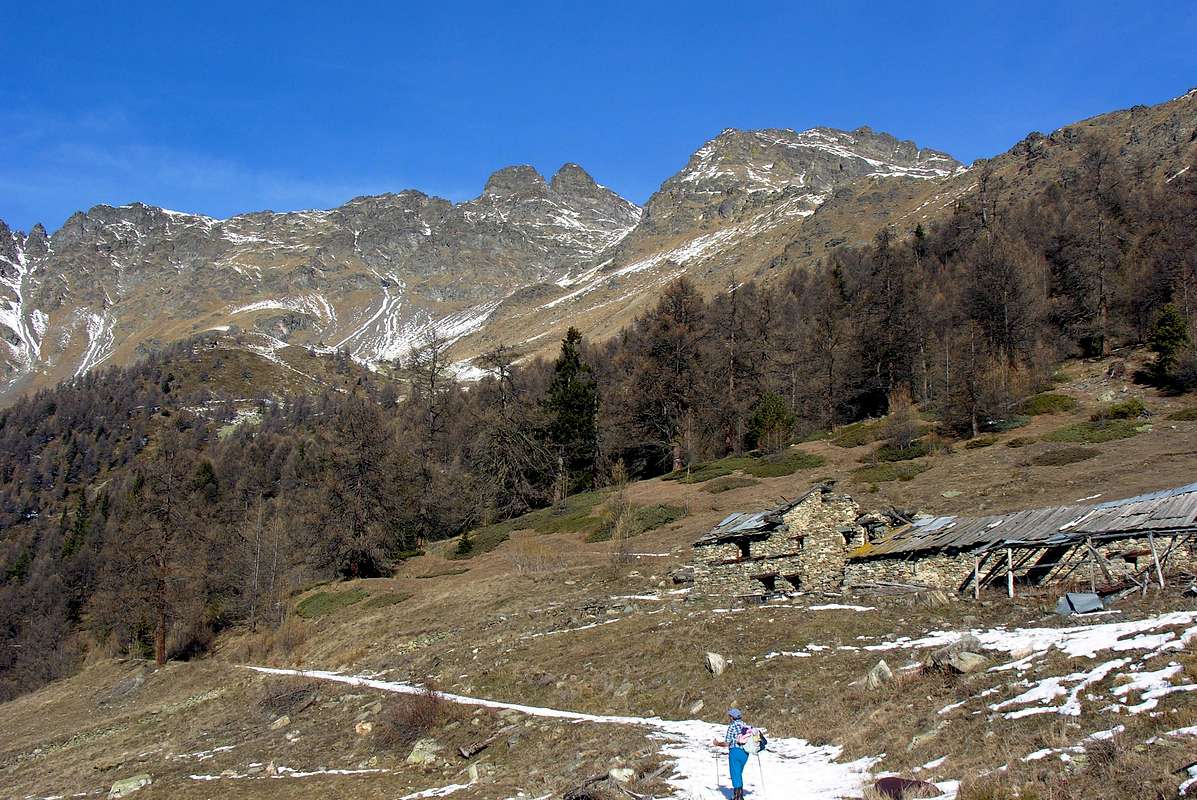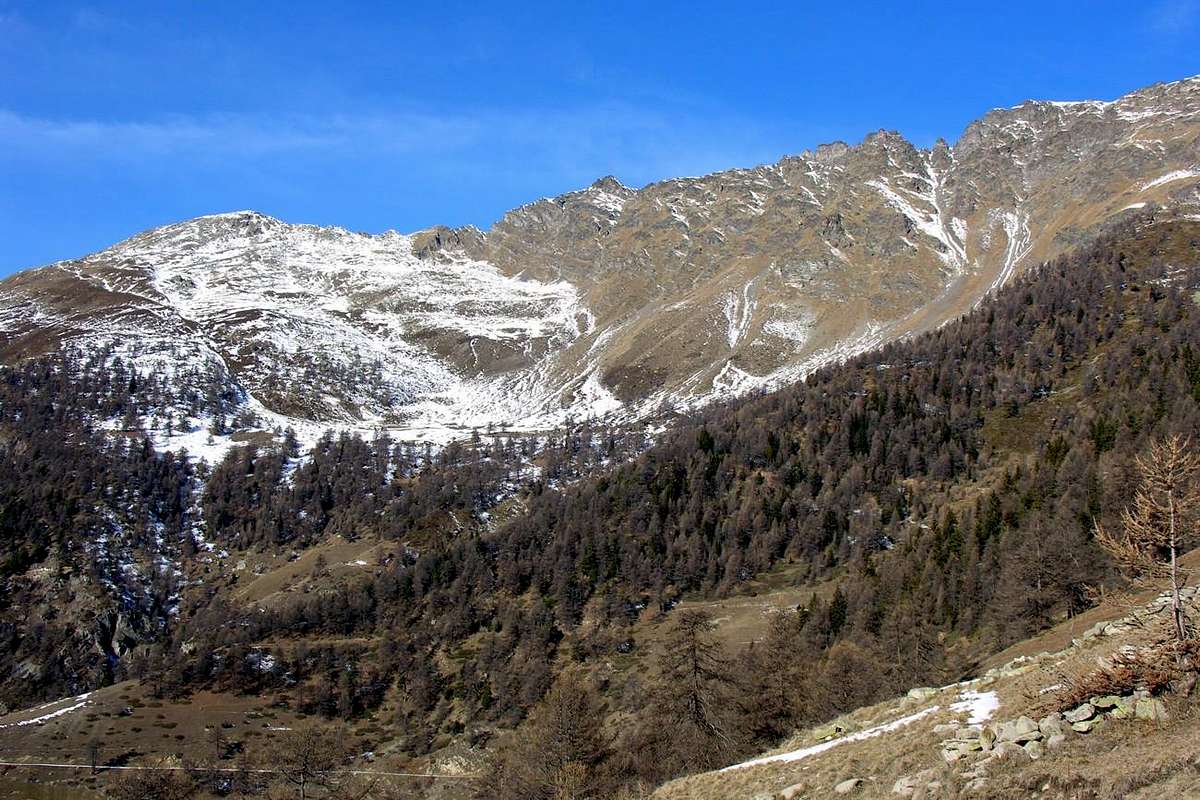-
 735 Hits
735 Hits
-
 79.78% Score
79.78% Score
-
 11 Votes
11 Votes
|
|
Mountain/Rock |
|---|---|
|
|
45.79990°N / 7.38872°E |
|
|
Mountaineering |
|
|
Summer, Fall |
|
|
9439 ft / 2877 m |
|
|
Note
|
La montagna chiama i suoi figli, ed essi rispondono fedelmente al suo appello… Osvaldo Cardellina, Diario alpinistico, 1964-65 Page texts: @ OsvaldoCardellina "Osva", passed away on May 2, 2022. Page owners: Christian Cardellina e Osvaldo Cardellina. Any updates from September 12, 2022: Antonio Giani, page administrator, friend and climbing companion. Testi della pagina: @ OsvaldoCardellina "Osva", scomparso il 2 maggio 2022. Proprietari pagina: Christian Cardellina e Osvaldo Cardellina. Eventuali aggiornamenti dal 12 settembre 2022: Antonio Giani, amministratore della pagina, amico e compagno di salite. |
Overview
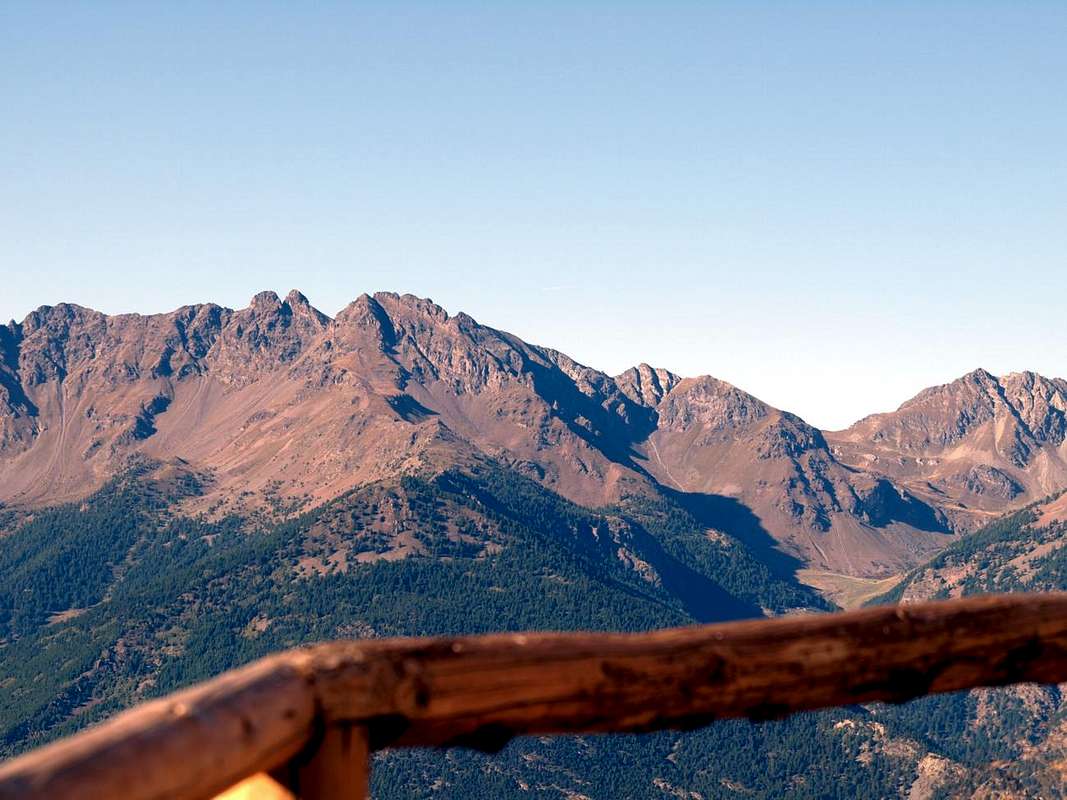
Small Bell Tower also Spire of Senevé (2.875/7 meters around); so she was baptized this slender and lower case rocky pyramid, who owns the lines of a Matterhorn in miniature, from the underlying place immediately (2.928m). Compressed of two lateral rocky collets to the West and East, it is actually an intermediate spire between the altitude of 2.888 meters and precisely the Punta di Senevé with its top formed by three small distinct elevations. All along that long watershed between Valpelline and the Central Valley of the Dora Baltea that from Becca di Roisan or Becca di Pechenville (2.546m) "flows" towards the East forming a series of mountains that from 2.856 meters of Becca di Viou reach the double tops of Tsaat à l'Etseina od Etsena (Western about 2.971, Eastern about 2.974/5 meters), where the ridge unfolds in two parts:
1) - the first climbs over the Becchi di Fana (2.951m) or, more precisely, reached the Westernmost one (2.945m) declines decisively in the South up to the balcony of the Croix de Fana (2.212m);
2) - the second to "escape" towards the North and, after having formed the Punta Joseph Maria Henry (2.918m) and the Becca Conge (2.954m), it spreads slightly to the Northeast until it reaches the important Col de Saint Barthélemy (2.645m), sited between Comba Dèche (little basin by Quart Municipality) and Comba Verdona (Valpelline). In the intermediate part of this partition, that is between Mont Mary or Mont Saint Joseph (2.815m) and the Eastern Point of the Tsaat à l'Etsena (Eastern about 2.974/5 and not about 2.967 meters and Western 2.971 meters, exactly the opposite in height to what is stated in Vol. II of "Alpi Pennine" edited by Gino Buscaini in which, between pages 571/573, the East Tip is quoted in about 2.967 meters and the West in 2.971 meters IGM; the all is the result of analyzes carried out by me following numerous personal ascents, also in different winter seasons),), the crest proceeds pseudo-rectilinearly forming the Punta di Chamerod (about 2.750/7 meters), the Punte de Les Prèles or Preyes also Preilles (about 2.747/8 meters the forked or Western Summit, 2.750/1 meters around the Eastern Top), between the two Cols de Chaudière (2.680 meters the Eastern and even the unique practicable), the Tête d'Arpisson (2.856m), the complex Altitude 2.888 meters and then descend bristling with a whole series of spiers on the underlying double collar of Senevé on which "our" bell tower rises for about fifty meters. All this is clearly visible from the valley floor in the stretch of road or highway that from the Municipality of Nus (529m) reaches that of Quart-Villefranche (526m) and then in succession Saint Chistophe (573m) and Aosta City. Seen from this side or from the South, it has a steep triangular wall divided into two parts by a small edge just mentioned; the same infuses itself for another thirty meters in a detrital-snowy channel, in which the aspect changes between one and the other state towards the beginning of summer, and then returns to the snow towards the end of the autumn-early winter. On the opposite side, that is the Northern one, the spire appears less abrupt and more "malleable" with two faces turned over the narrow and "rectangular" Comba of Fouillou, located between the Punta di Senevé and the Tête d'Arpisson and used in the last years of the 1900 for the ski-mountaineering trip to the first (Senevé) starting from Valpelline-Prailles location (942 meters near the "Camping Grand Combin") and through the very wooded Comba di Arpisson or Arpisson 's little Basin. On this side, a small ledge at the base of the spire allows, going down quite easily about ten meters, the passage between the two similar collars (Western and Eastern, the booth about 2.850 meters). The Eastern Collar can also be reached from the Punta di Senevé or Cénevé with a brief descent along its short (about eighty meters), but steep West-southwest Ridge, as did the a group of roped climbers of October 08th, 1972, which here he stopped without climbing the Senevé's also Cénevé's Spire or Bell Tower and then went back on the main Senevé Summit with the same itinerary. A small spire that in second photo just below can clearly be seen also on the Valpelline side, as well as immediately to the right (West) of Punta di Senevé or, on the opposite side of the Dora, also known as Punta di Cénevé. It results climbed for the first one turned by Osvaldo Cardellina the 11 of October 1992 in the long and weary crossing in crest from Becca of Roisan to the Croix de Fana; the rope 1972 Quendoz-Jorrioz discarded to the right it immediately attaching on the fork to East, coming from the evident and quite steep, but easy, detrital gully to start the partial crossing on the ridge up to Colle di Fana (2.880 m).
![]()
Long watershed from Mont Mary towards Becchi di Fana and between Cénevé (right) & Arpisson-Fouillou Vallons
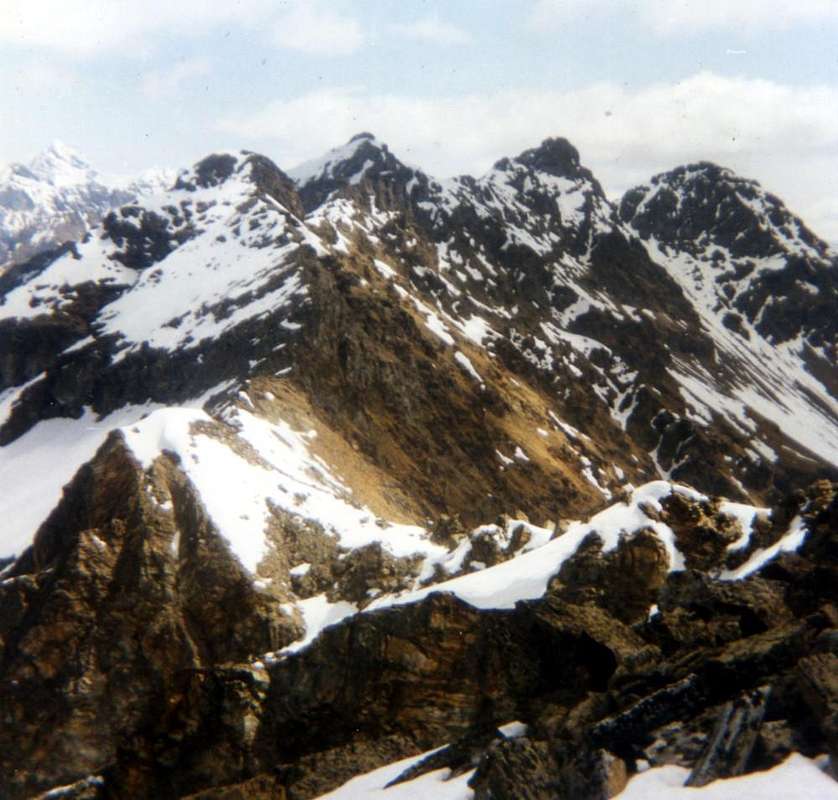
Campanilino o Guglia di Senevé (2.875/7 metri circa); così é stata battezzata questa slanciata e minuscola piramide rocciosa, che possiede le linee di un Cervino in miniatura, dal nome della località subito sottostante l'omonima punta (2.928 m), ampio bacino rivolto alla Valle Centrale della Dora Baltea. Compresso da due colletti rocciosi laterali ad Ovest ed ad Est, in realtà é una guglia intermedia tra la Quota 2.888 metri ed appunto la Punta di Senevé, quest'ultima con la sua sommità formata da tre piccole elevazioni distinte. Il tutto su quel lungo spartiacque tra la Valpelline e la Valle Centrale della Dora Baltea che dalla Becca di Roisan o Becca di Pechenville (2.546 m) "scorre" verso Oriente formando una serie di montagne che dai 2.856 metri della Becca di Viou raggiungono la duplice Tsaat à l'Etseina od Etsena (circa 2.971 metri l'Occidentale e circa 2.974/5 metri l'Orientale ), là dove la cresta si dispiega in due parti:
1) - la prima scavalca i sette Becchi di Fana (2.951 m) o, più esattamente, raggiunta l'antecima Occidentale (2.945 m) declina decisamente a Meridione fino a raggiungere la balconta della Croix de Fana (2.212 m);
2) - la seconda "scappa" verso Settentrione e, dopo aver formato la Punta Joseph Maria Henry (2.918 m) e la Becca Conge (2.954 m), dispiega leggermente a Nordest fino a raggiungere l'importante Col de Saint Barthélemy (2.645 m) per poi rialzarsi con la Punta di Verdona (2.868m). Nel tratto intermedio di questo divisorio, cioé tra il Mont Mary o Mont Saint Joseph (2.815 m) e la Punta Orientale della Tsaat à l'Etsena (Sommità Orientale 2.974/5 metri circa e non 2.967 metri circa nonché Cima Occidentale 2.971 metri, esattamente al contrario in altezza di quanto reciti il Vol. II di "Alpi Pennine" a cura di Gino Buscaini nel quale, tra le pagine 571/573, si quota la Punta Est in 2.967 metri circa e la Ovest in 2.971 metri IGM; il tutto frutto di analisi da me effettuate a seguito di numerose personali ascensioni, anche in diverse stagioni invernali), la cresta procede in maniera pseudo-rettilinea formando la Punta di Chamerod (2.750/7 metri circa), le Punte de Les Preles, tra i due Colli di Chamerod, la Tête d'Arpisson (2.815 m) quest'ultima conosciuta anche come Pelon de Quart, la complessa Quota 2.888 metri per poi scendere irta con tutta una serie di guglie sul sottostante doppio colletto di Senevé sul quale si innalza per una cinquantina di metri il "nostro" Campanile. Tutto questo risulta ben visibile dal fondovalle nel tratto di strada o di autostrada che dal Comune di Nus (529 m) raggiunge quello di Quart-Villefranche (526 m) e poi in successione Saint Chistophe (573 m) ed Aosta. Visto da questo lato o Meridionale, presenta una ripida parete triangolare divisa in due parti da uno spigoletto appena accennato; la medesima si infonde per un'altra trentina di metri in un canale detritico-nevoso, nel quale l'aspetto muta tra l'uno e l'altro stato verso l'inizio dell'estate, per poi ritornare innevato verso la fine dell'autunno-inizio dell'inverno. Sul lato opposto, ovvero Settentrionale, la guglia appare meno abrupta e più "malleabile" presentando due facce rivolte sopra la stretta e "rettangolare" Comba di Fouillou, situata tra la Punta di Senevé e la Tête d'Arpisson nonché utilizzata negli ultimi anni del 1900 per la gita sci-alpinistica alla prima partendo da Valpelline ed attraverso la Comba di Arpisson. Su questo lato, una piccola cengia alla base della guglia permette, scendendo abbastanza facilmente di una decina di metri, il passaggio tra i due colletti (Occidentale ed Orientale 2.850 metri circa per entrambi). Il Colletto Orientale può essere raggiunto anche dalla Punta di Senevé o Cénevé con una breve discesa lungo la sua corta (all'incirca un'ottantina di metri), ma ripida Cresta Ovest-sudovest, come fece la cordata dell'8 di Ottobre 1972, che qui si fermò senza scalare il Campanile oppure Guglia di Senevé per poi risalire sulla medesima Punta di Senevé con lo stesso itinerario. Una piccola guglia che nella foto appena qui sotto si può chiaramente individuare anche sul versante della Valpelline, nonché subito a destra (Ovest) della Punta di Senevé o, dal lato opposto della Dora, conosciuta anche siccome Punta di Cènevé. Risulta salito per la prima volta da Osvaldo Cardellina l'11 di Ottobre 1992, nella lunga ed estenuante traversata in cresta dalla Becca di Roisan alla Croix de Fana; la cordata Quendoz-Jorrioz dell'estate 1972 lo scartò a destra attaccando sulla forcella immediatamente ad Est, provenendo dall'evidente ed abbastanza ripido, ma facile, canalone detritico per iniziare la parziale traversata in cresta insino al Colle di Fana.
![]()
Same watershed in opposite or Northern side from Becca de Viou towards Bell Tower & Pointe de Senevé between Valpelline/Central Valleys

First Ascents
- First on Summit: Osvaldo Cardellina, lone, (October 11th, 1992), from Quota 2.888 meters through before the Western Crest and after by Northwestern Face, in ascent and in descent, during the Great Traverse. from Becca Roisan-Quota 2.494 meters also Becca de Blavy-Becca Viou-Mont Mary or Mont de Saint Joseph-Chamerod and two Les Preles Points-Tête d'Arpisson or Pelon de Quart-Quota 2.888 meters-Senevé Point-Quota 2.945/50 meters about-Tsaat à l'Etsena West/East-Becchi di Fana-Croix de Fana: Osvaldo Cardellina, lone (Oct 11th, 1992), Blavy to Trois Villes Villages (the middle of Avisod).
- First repetition or second ascent of Summit: Osvaldo Cardellina and Alessandro Cardellina, (July 18th, 2005), from Chamerod Village towards the Quota 2.888 meters, after the first ascent on Southern Face of the same, through before the Western Crest and after by Northwestern Face,, in ascent and in descent, during the crossing up to the Punta di Senevé; in descent S-SE Rib to Senevé or Cénevé Alp.
- First in winter: not yet climbed.
- Western Ridge and Northwestern Face: Osvaldo Cardellina, solo, (Oct 11th, 1992), during the integral and complete traverse from Becca de Roisan up to the Croix de Fana.
- First on the Eastern Collar: Renato Quendoz and Jules Jorrioz (summer or autumn ? 1972), first arriving from Testa d'Arpisson in traverse towards Quota 2.888 meters and in descent from this and through subsequent traverse from the Western Collar at the base of Senevé Bell Tower, after reaching the western Summit of Tsaat à l'Etseina.
- Second on the Eastern Collar: repeated by Osvaldo Cardellina and Camillo Roberto Ferronato (October 08th, 1972) but with descent on West-Southwest Crest of Punta di Senevé.
- First on the Western Collar: Renato Quendoz and Jules Jorrioz (summer or autumn ? 1972), in descent from Quota 2.888 meters. Second on the Eastern Collar: Osvaldo Cardellina, lone, (October 11th, 1992), always coming downhill from Quota 2.888 meters and before the first ascent on Cénevé Spire .
Getting There
BY CAR:
- From TORINO, MILANO, etc: Motorway A5. Exit at IVREA or Quincinetto (PIEDMONT).
- From IVREA Town: in West (Southern side) towards Pont Saint Martin, Donnas, Bard, Champdepraz, Pontey, Fénis, Nus to Quart-Villefranche and Saint Christophe Municipalities (Eastern Side). From Courmayeur Resort: in East towards Pré Saint Didier, Morgex, Arvier, La Salle, Saint Pierre, Sarre, Aosta to Saint Chistophe and Quart Municipalities (Western Side).
- North-northeastern Sides:
- From Aosta Town to Verrès Municipality From Saint Christophe-Prevot (about 640m), reached by Regional Road from Aosta, to Sorreley Village; from this, with Municipal, towards Veynes Fraction. From subsequent alternative before Lumian (1.025m): *** in East deviation to Cretallaz, Jeanceyaz, Morgonaz Villages at the entrance on Senevé Comba). On asphalt road in Northwest, to Parléaz Village (1.274m), Blavy Hamlet (1.475m) and, through dirt road or path, to Viou Alpages, in Blavy Viou small Basin. From Quart-Villair towards Epilaz, Argnod Villages or from SS.26 nearby La Plantaz (540m), with Regional and Municipal Roads, towards Chétoz, Vignil, Fornail, Ville sur Nus-Planeville, Buignod, Porsan Villages to Trois Villes-Avisod Village (1.398m). From this to Senevé Alps (2.206m), in Senevé Comba. From Quart to Fonteil with previous route; from this through dirt road, towards La Seyvaz (2.184m), Valchourda Alps (2.392m), in Comba Dèche. From Nus-La Plantaz in State Road to Ville sur Nus-Planeville (1.113m); from this, towards Buignod, Avion (1.312m) Villages. Also from Porsan through Trois Villes (1.398m), Avion, fork (1.250m) to Effraz Village (1.487m), with Municipal Roads. From this to Ronc (1.737m), Machaussy Alps, in Effraz Comba.
- Specific Road: just after Quart Fractions (Etolin, Vieille Morte, la Plantaz-Chétoz (better), turn to the left or North-northeast, towards Trois Villes (two parkings). Or with alternative road: from Aosta East toll of the highway follow on the right side toward Quart (556m near the Region Amérique); after the roundabout follow up toward Villair. After passing Argnod (857m) and Ville sur Nus (1.106m) turn to the left to Trois Villes Avisod (1.391m) wherefrom you must start walking. Or by Nus adjacent Commune.
- From FRANCE: through the Mont Blanc Tunnel to Entrèves-crossroads to Vény/Ferret Valleys - Mountain Guides of Courmayeur - La Saxe Rock Gym - Courmayeur. By Little Saint Bernard Pass, closed since November until half May to La Thuile Valley - Pré Saint Didier - Courmayeur. It is not necessary to take Motorway A5: you can drive on SS.26, in the direction of AOSTA - IVREA - TURIN.
BY PLANE:
- Aeroporto "Corrado Gex" Saint Christophe (Aosta).
Approaches from Chamerod or by Avisod Villages
Approach A (from Trois Villes Villages): Avisod Hamlet (1.390m; beautiful small church in the meadow back 1.398 meters, just to East) to take toward West the dirt road, leaving on the left the alternative for Valseinte shortly after (1.399m; attainable with beautiful walk through the path that from the beautiful one and restructured Castle of Quart (740m) it transits for the Oratoire de Saint Emeric (1.140m) with a slendid walk); to continue instead more toward Northwest progressively inserting himself in the Basin Senevé, leaving in low the Alps Chacotte (1.426m) and Séchot (1.409m). To revolve the wooded strata of the Slope Southwest of the Croix de Fana (2.212m; beautiful walk with departure from Trois Villes-Fonteil) and, crossing some small torrential furrows, to reach the Champchamoussin Pasture before Lower and immediately than Upper (1.856m); from this, always with slope in diagonal but more towards Northwest, to reach the Alpe of Latta or Lattaz (1.930m; today almost in complete ruin), underlying to the With the Cornet (2.272m), and the following double and wide hairpin bend to altitude 2.036 meters. To continue, same direction, toward the Chavod Pasture (2.038m) and the following winding road in form of acute angle to quota 2.097 meters; from this the dirt road changes direction in Northeast reaching the following of 2.148 meters, where the path n° 1 arrive that it goes down from the aforesaid hill. From here the road it decidedly turns to West and it reaches shortly time the important Senevé Alp, recently restructured (2.199m; E; 2h'00/2h'30; there is no other possibility of course, because the path has been progressively in the time cleared by the farms dirt road). Note: This beautiful approach can also be carried out in winter with Skiing or Snowshoeing starting from the small Village of Avisod (the second of three of Trois Villes).
![]()
At the base of Tête d'Arpisson-Punta Senevé in Autumn 1971
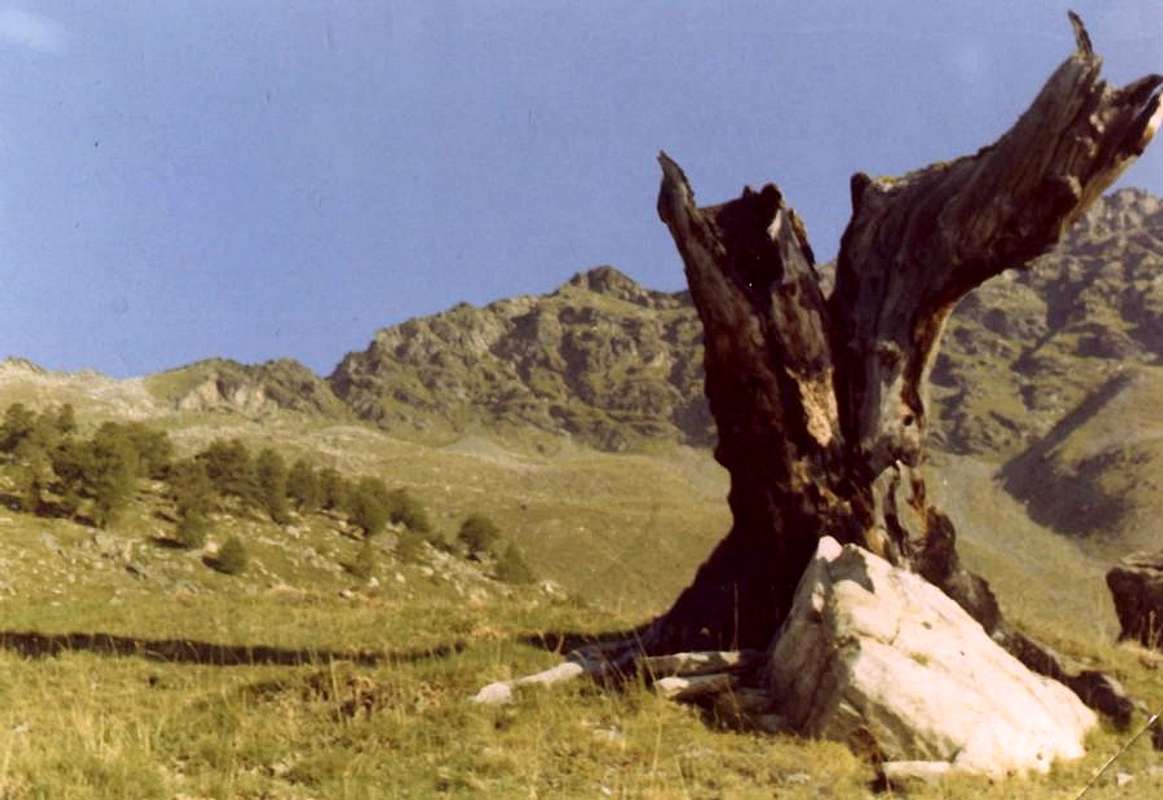
Avvicinamento A (dai Villaggi di Trois Villes): dal Villaggio di Avisod (1.390 m; chiesetta nel dosso prativo 1.398 metri, subito ad Oriente) prendere verso Occidente la strada poderale, lasciando poco dopo sulla sinistra il bivio per la Valseinte (1.399 m; raggiungibile con bella passeggiata tramite il sentiero che dal bel e recentemente ristrutturato Castello di Quart (740 m) transita per l'Oratorio di Sant'Emerico (1.140 m) con una splendida passeggiata/escursione); continuare invece più verso Nordovest inserendosi progressivamente nella Conca di Senevé, lasciandosi in basso le Alpi Chacotte (1.426 m) e Séchot (1.409 m). Aggirare le falde boschive del Versante Sudovest della Croix de Fana (2.212 m; bella passeggiata con partenza da Trois Villes-Fonteil) ed, attraversando alcuni piccoli solchi torrentizi, raggiungere l'Alpe Champchamoussin di Sotto e subito dopo di Sopra (1.856 m); da questa, sempre con salita in diagonale ma più a Nordovest, raggiungere l'Alpe di Latta o Lattaz (1.930 m; oggi quasi in completa rovina), sottostante al Col Cornet (2.272 m), ed il successivo doppio e largo tornante a quota 2.036 metri. Proseguire, stessa direzione, verso l'Alpe di Chavod (2.038 m) ed il successivo tornante in forma di angolo acuto all'altitudine di 2.097 metri donde la strada cambia direzione in Nordest raggiungendo la successiva di 2.148 metri, ove arriva il sentiero n° 1 discendente dal suddetto colle. Da qui la medesima volge decisamente ad Ovest e raggiunge in breve tempo l'importante Alpe, da poco ristrutturata, di Senevé (2.199 m; E; 2h'00/2h'30; non esiston altre possibilità di percorso, poiché il sentiero è stato cancellato progressivamente nel tempo dall'abbastanza recente strada poderale).
Nota: questo bell'avvicinamento può essere effettuato anche in inverno con gli Sci o le Racchette da neve partendo dal Villaggio di Avisod (il secondo dei tre di Trois Villes).
![]()
Senevé Comba with farms dirt road from Davisod (Trois Villes)
Equipment For Mountaineering: rope; ice-axe and crampons in late spring.
Da Alpinismo con corda; piccozza e ramponi in tarda primavera.
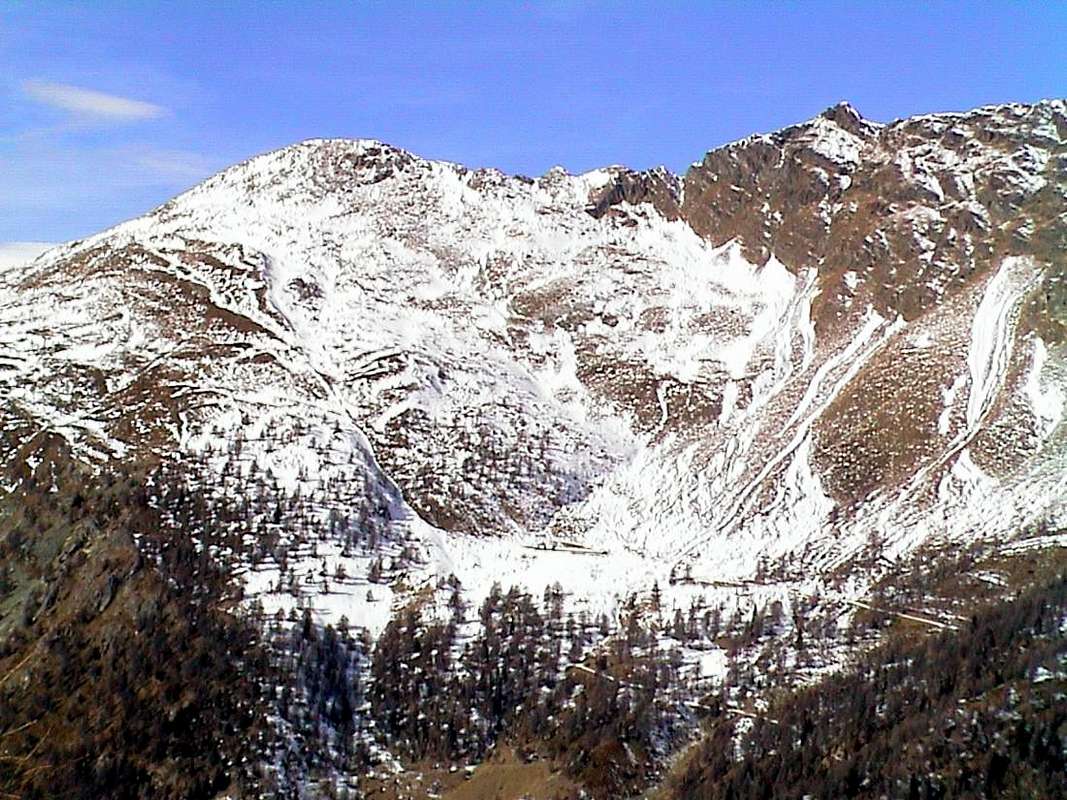
Approach B (from the Hamlets of Crétallaz-Jeanceyaz-Morgonaz through the Municipal Road by Saint Christophe) from Prayon Farm (1.128m), almost at the end of the Municipal Road that goes by St. Christophe Common, along the farms private dirt road, at the hairpin bend just over the water intake, towards Les Ayettes (1.463m) and Bor(r)elly (1.477m) Pastures at the entrance on Senevé Basin, Western side or Chamerod's, reaching, always towards the North, this ancient village where once (until the Seventies) there were two wonderful wooden "Rascards"with stone base (1.615m, E; 1h'15/1h'30, the sign ban immediately after the water intake of Prayon Farm). If you want you can avoid reaching the same continuing left before of 200 meters about on the above dirt road that, after a wide bend crossing two unimportant torrents and passing over the Alp Tsamp Dèsott or Tsamp des Eaux (*** for an existing source just above 1.660/70 meters about GPS; private and always closed, owned by Aldo Barmasse that in winter "beats" the farm road with the snowmobile), to Alp Les Preyes or Les Prèles and also, on the spot, Priles (1.802m), just beyond which is terminated. From this point to the North part of a small path unnumbered that, almost immediately past right an ancient ruin, is introduced into the overhanging woods; climbed the same with tight bends (path not easy to detect in the presence of snow) and with a final hairpin out on the lawns and most recently with a right diagonal in the midst of these towards the Alp Cénevé (2.206m; source immediately to the West at a water intake; E; 2h'30/2h'45, increasing by about an good hour in the event of snow). This approach is more direct but also more tiring than with long diagonal from Avisod of Trois Villes.
Note: also this approach is already in a splendid outing with snowshoes usually starting from just above Prayon and passing through the alps above or with shortcuts.
![]()
To Cénevé Comba from Prayon Farm & Chamerod by Snowshoes
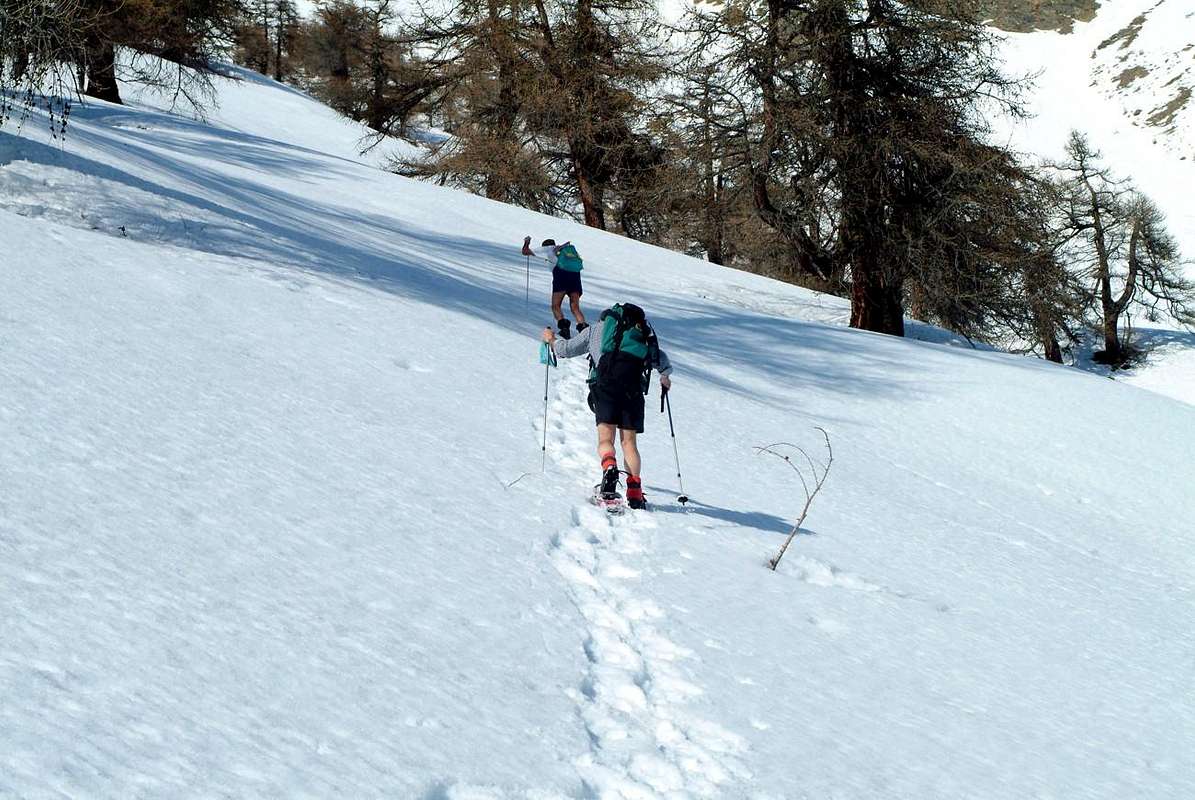
Avvicinamento B (dai Villaggi di Crétallaz-Jeanceyaz-Morgonaz con la Strada Comunale da Saint Christophe): dalla Fattoria di Prayon (1.128 m) tramite la strada poderale, presso il tornante a gomito appena oltre la presa d'acqua, per i successivi Alpeggi di Les Ayettes (1.463 m) e Bor(r)elly (1.477 m) all'ingresso nel Bacino di Senevé, settore Occidentale o di Chamerod, raggiungendo, sempre verso Settentrione, questo antico villaggio, dove una volta (fino agli anni Settanta) esistevano due splendidi "Rascards" in legno con basamento in pietra (1.615 m, E; 1h'15/1h'30 dal cartello di divieto di transito subito dopo la presa d'acqua). Volendo si può evitare di raggiungere il medesimo svoltando a sinistra appena 200 metri circa prima sulla soprastante poderale che, dopo un largo tornante, superando due torrentelli secondari e passando sopra l'Alpe Tsamp Dèsott o Tsamp des Eaux (*** per una sorgente esistente poco sopra 1.660/70 metri circa GPS di proprietà di Aldo Barmasse che in inverno "batte" la strada poderale con la motoslitta), raggiunge l'Alpe di Les Preyes o Les Prèles ed anche, in loco, Priles (1.802 m), poco oltre la quale essa termina. Da questo punto s'indirizza verso Nord un sentierucolo non numerato che, passando quasi subito accanto ad un rudere, si introduce progressivamente nel bosco; risalito lo stesso con stretti tornanti (percorso non facile da individuarsi in presenza di neve) e con un ultimo tratto più ripido esce sui prati ed infine con un diagonale verso destra in mezzo a questi verso l'Alpeggio di Cénevé (2.206 m; sorgente subito ad Ovest presso una presa d'acqua; E; 2h'30/2h'45, aumentando di circa una buona ora con neve). Questo avvicinamento risulta più diretto ma anche più faticoso rispetto a quello in diagonale da Trois Villes.
Nota: anche quest'avvicinamento consiste già in una spledida gita con racchette da neve in genere partendo da Prayon, passando dalle alpi di cui sopra o con scorciatoie.
From Chamerod Village (1.614/38m), destroyed and today restructured, towards Senevé also Cénevé Alp (2.196m) at the base of Senevé bell Tower or Spire
![]()
On very wild watershed above Senevé or Cénevé Basin
Route
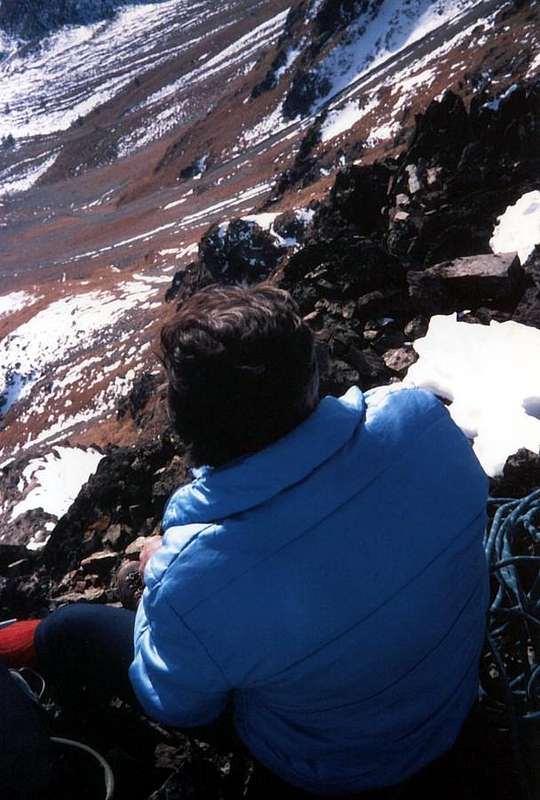
There are various hypotheses of ascent to this small and slender spire, which stands out clearly in the continuity line of the watershed, clearly showing itself between the jagged altitude 2.888 meters and the Punta di Senevé:
a) - as for the first climber 1992, reach the "Colletto" (Collar) Western with a descent from altitude 2.888 meters and overcome the Western Crest also leaning to the adjacent Northwest Face.
b) - from Punta di Senevé (2.928 meters) descend, as in October 1972, for its West-Southwest Ridge reaching the Eastern Little Fork (always 2.850 meters) and from this, after having lowered slightly along a small ledge with path inverse, not difficult but fairly exposed, compared to that of 1992, to join the previous itinerary.
c) - Use, in the case of a further partial alternative to the crossing made by the a group of roped climbers Quendoz-Jorrioz 1972 way, the Southern snowy or debris Channel (as seen in the photo in "primary image" in an initial "taste" during the ascent to Punta di Senevé on 8 October 1972 then carried out more to the right or East via the adjacent rocky spur facing South-southeast) that leads to the base of the "Paretina Sud" (Southern Little Wall) of the Guglia di Senevé and from this point exit on the Colletto Orientale, whence the previous itineraries; or, with a small variant, go out on the Western Collar passing a small rocky wall of about 15 meters and then always with the same route on the Bell Tower of Cénevé. As for the third hypothesis, certainly the simplest and least complicated as well as the least long, that is, from the Comba di Senevé via the Southern Canal, reach the base of the same by crossing the stony ground towards the Northeast from the Alps. Reached the base of the same, where this ends with a large grassy slope with small scattered blocks, it is followed faithfully and easily to its end and without a mandatory path but following a logical succession with various zigzags until reaching the end of the channel sinuous formed by a greyish stony ground. With a first course towards the Northeast, a narrowing formed by evident and opposite whitish rocks is reached; from this point go up more directly to the North-northwest, always along the shatter flow which becomes gradually steeper (40 ° with snow). Reached the East-Southeast Ridge, which comes from the various indentations of the altitude of 2.888 meters, you follow it for a short time in the opposite direction or on the right going up; then, losing a little in altitude, you reach a very inclined ledge that leads to the base of the small Norhwest Wall, after which (from the II°-to III°+) in a short time you reach the narrow top of the pyramidal spire (EE/A; from F+ to AD-/AD; 2h'15/2h'30 Cénevé Alp). You can probably ascend also from the opposite or Southern side or from the Senevé Comba or Cénevé Basin using, after the ascent into the detrital or snowy channel, one of the two small walls divided by a small edge: foresee a slightly longer climbing (from 10 to about 15 meters) and certainly more demanding (almost probably through bottom-up analysis, (from the III°/III°+ to the IV°?).
IN DESCENT: with the same route, or go up to the nearby Punta di Senevé via the West-Southwest Ridge and descend from it along the Normal Via which "winds" along the fairly simple Southeastern Outcrop.
The first approaches from Pointe de Senevé or Cénevé towards the Senevé 's Bell Tower below Quota 2.888 meters (just in foreground from Summit and from base)
Varie sono le ipotesi di salita a questa piccola e slanciata guglia, che si distacca nettamente nella linea di continuità dello spartiacque evidenziandosi nettamente tra la frastagliata Quota 2.888 metri e la Punta di Senevé:
a) - come per il primo salitore 1992, raggiungere il Colletto Occidentale in discesa dalla Quota 2.888 metri e superare la Cresta Ovest appoggiandosi anche all'attigua Faccia Nordovest.
b) - da Punta di Senevé (2.928 metri) scendere, come nell'ottobre del 1972, per la sua Cresta Ovest-sudovest raggiungendo la Forcella Orientale (sempre 2.850 metri) e da questa, dopo essersi abbassati leggermente percorrendo una piccola cengia con percorso inverso, non difficile ma abbastanza esposto, rispetto a quello del 1992, riunirsi all'itinerario precedente.
c) - Utilizzare, nel caso di ulteriore parziale alternativa alla traversata effettuata dalla cordata Quendoz-Jorrioz 1972 partendo dalle Testa di Arpisson, il canale Meridionale (come si vede nella foto in "primary image" in un "assaggio" iniziale durante l'ascensione alla Punta di Senevé dell' 8 Ottobre 1972 poi effettuata più sulla destra od Est tramite l'attiguo sperone roccioso rivolto a Sud-sudest) che conduce alla base della Paretina Sud della Guglia di Senevé e da questo punto uscire sul Colletto Orientale, donde ai precedenti itinerari; oppure con una piccola variante uscire sul Colletto Occidentale superando una paretina rocciosa di circa 15 metri e quindi sempre con la stessa via sul Campanile di Cénevé. Per quanto concerne la terza ipotesi, sicuramente la più semplice e meno complicata oltre che meno lunga, ovvero dalla Comba di Senevé tramite il Canalone Sud, raggiungere la base dello stesso attraversando dall'alpe le pietraie verso Nordest. Raggiunta la base del medesimo, dove questo termina con un largo pendio erboso con piccoli blocchi sparsi, lo si segue fedelmente e facilmente sino al suo termine e senza percorso obbligato ma seguendo una successione logica con vari zig-zag fino a pervenire al termine del canale sinuoso formato da una pietraia grigiastra. Con andamento dapprima verso Nordest si raggiunge una strozzatura formata da evidenti ed opposte rocce biancastre; da questo punto risalire più direttamente verso Nord-nordovest, sempre lungo la colata di frantumi che diviene via via più ripida (40° con neve). Raggiunta la Cresta Est-sudest, che proviene dalle varie frastagliature della Quota 2.888 metri , la si segue per breve tempo in direzione opposta ovvero a destra salendo (Est); quindi, perdendo un poco in altitudine, si raggiunge una cengetta molto inclinata conducente alla base della Paretina Nordovest, superata la quale (dal II° - al III°+) in breve si raggiunge la più che stretta sommità della guglia piramidale (EE/A; da F+ ad AD-/AD; 2h.15'/2h.30' dall'Alpe di Senevé). Probabilmente si può effettuare l'ascensione anche dal lato opposto o Meridionale ovvero dal Bacino di Senevé utilizzando, dopo la risalita nel canale detritico o nevoso, una delle due paretine divise da uno spigoletto: prevedere una arrampicata appena più lunga (dai 10 ai 15 metri circa) e sicuramente più impegnativa (dal III°/III°+ al IV° ?).
IN DISCESA: stessa via, oppure risalire alla vicina Punta di Senevé tramite la Cresta Ovest-sudovest e scendere dalla medesima lungo la Via Normale che si "snoda" lungo l'abbastanza semplice Sperone Sudest.
![]()
Winter watershed from West Tsaat à l'Etesena to Senevé, Tête d'Arpisson, Mont Mary, Pass and Becca de Viou.
Near Latta Alp, towards the traverse from West (left) to the East on Mary-Arpisson-Senevé Range by emilius on 31th December 2006
In tarda primavera, preferibilmente in estate od all'inizio dell'autunno.
Da PD/PD+ ad AD- (brevi passaggi di i°/II°/II°+ e III°- ed uno breve di III°+).
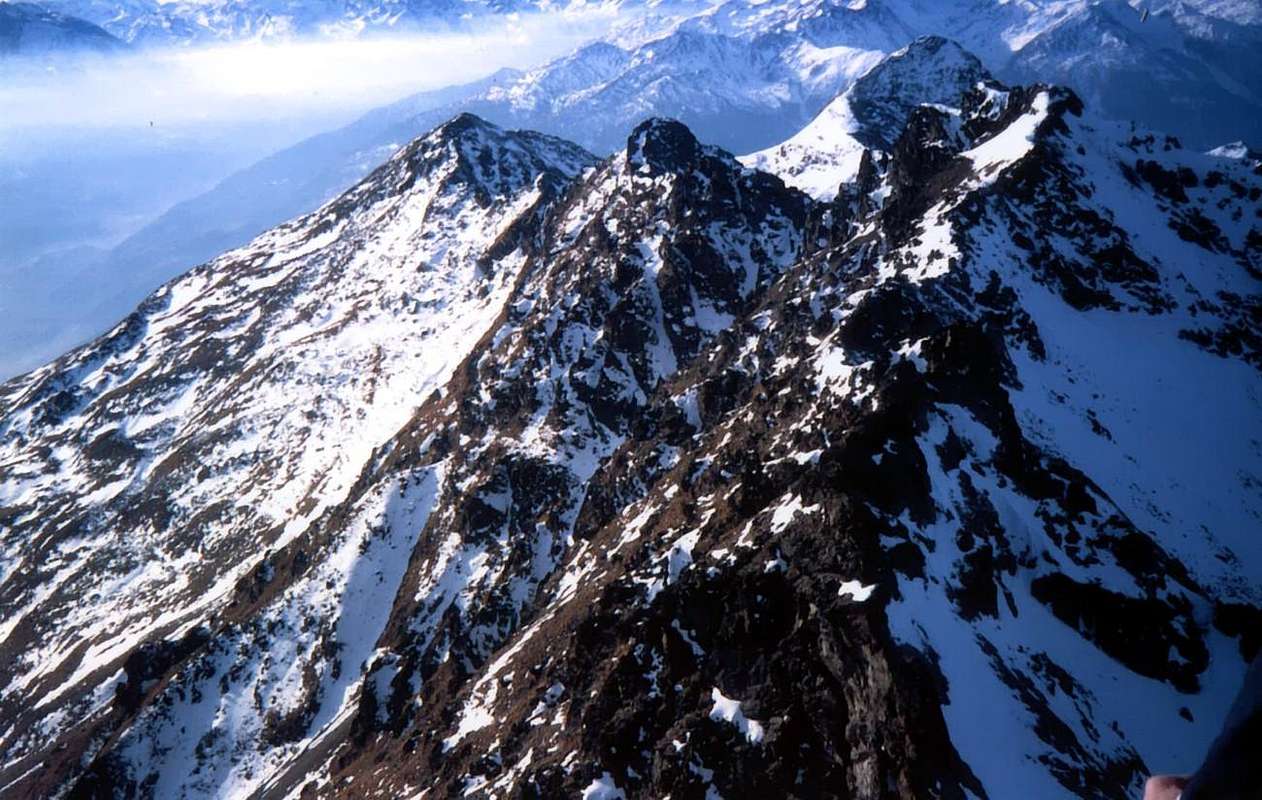
When to Climb
In late spring, preferably in summer or at the beginning of autumn.In tarda primavera, preferibilmente in estate od all'inizio dell'autunno.
Equipment and difficulties
Difficulties From PD/PD+ to AD- (short passages of I°/II°/II°+ and III°- and one brief of III°+).Da PD/PD+ ad AD- (brevi passaggi di i°/II°/II°+ e III°- ed uno breve di III°+).
Partial crossing from West (left) to the East on Mary-Arpisson-Senevé Range by emilius on 31th December 2006
Equipment For Mountaineering: rope; ice-axe and crampons in late spring.
Da Alpinismo con corda; piccozza e ramponi in tarda primavera.
Mountain Condition
- Valle d'Aosta Meteo
- Meteo: you can find all the needed informations at the official site of the Valle d'Aosta Region:
Books and Maps
- "Guida dei Monti d'Italia - Alpi Pennine (Vol. 2)" di Gino Buscaini - Club Alpino Italiano/Turing Club Italiano, Luglio 1970 (In Italian).
- "80 itinerari di Escursionismo Alpinismo e Sci Alpinismo in Valle d'Aosta", di Osvaldo Cardellina, Ed. Musumeci, Giugno 1977 (in Italian); seconda Ed. Luglio 1981; terza Ed. Luglio 1984; (in French), prima Ed. Febbraio 1978; seconda Ed. Marzo 1980.
- "Diari Alpinistici" di Osvaldo Cardellina e Indice Generale accompagnato da Schedario Relazioni Ascensioni 1964-2019 (unpublished).
- Kompass "Breuil/Cervinia-Zermatt" Carta turistica 1:50.000.
- I.G.C. Istituto Geografico Centrale "La Valpelline" (carta n° 115) Map1:30.000.
- I.G.M. Istituto Geografico Militare - Map 1:25.000.
- L'Escursionista Ed. Rimini "Gran San Bernardo-Ollomont" (carta n° 5) 1: 25.000.
Important Information
- REGIONE AUTONOMA VALLE D'AOSTA the official site.
- FONDAZIONE MONTAGNA SICURA Villa Cameron, località Villard de la Palud n° 1 Courmayeur (AO) Tel: 39 0165 897602 - Fax: 39 0165 897647.
- SOCIETA' DELLE GUIDE DELLA VALPELLINE Etroubles-Strada Nazionale, n° 13 - Tel +39 0165 78559 - Valpelline-Loc Capoluogo, n° 1 - Tel +39 0165 713502 (AO) Italia.
- A.I.NE.VA. (Associazione Interregionale Neve e Valanghe).
Useful Numbers
- Protezione Civile Valdostana località Aeroporto n° 7/A Saint Christophe (Ao) Tel. 0165-238222.
- Bollettino Meteo (weather info) Tel. 0165-44113.
- Unità Operativa di Soccorso Sanitario Tel. 118.




